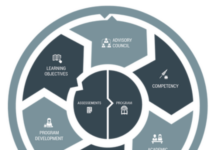One of the great things about e-learning is that it pops up in the most unexpected of places. This month’s New security learning, Issue, No. 5, 2011, is full of fascinating accounts of the way security, defence and emergency services are using e-learning or ICTs.
For example:
Online mentoring
Bruce, A. (2011) The Master’s Voice: Learning through Mentoring New Security Learning, Issue No. 5
This is a very good introduction to mentoring, its value and when it is appropriate. For instance:
One of the noted aspects of training and skill acquisition in traditional security environments has been the need to develop training standards, methods, materials and assessment systems in often rigidly hierarchical environments. The real contradiction is that most security and emergency situations do not themselves follow such pre-ordained and routinised procedures. The random and chaotic is more the norm. In such contexts, a premium is placed on very different skills: initiative, intuition, risk-taking and innovation in a contextual mix of experience and recalled best practice.
The article argues that mentoring provides an alternative route to ‘standardized’ approaches, then goes on to list some of the factors associated with successful workplace and school-based mentoring. Of particular interest is a report on the author’s experience from a European Commission funded project, ‘Sink or Swim’, in which virtual learning environments were used for workplace mentoring. [Note: I could find no links to the Sink or Swim program: I hope it hasn’t sunk. If you have a link, please let me know]
VLE supported mentoring has a number of defined benefits that include:
-
- Provision of 24 hour access for communication
- Accessible anywhere that has internet availability
- Provides a platform that does not require face-to-face communication
- Progress of the mentor/mentee relationship can be monitored by project leaders
As a result of the project it was felt that when using a virtual learning environment (VLE) it was important to consider a number of questions:
-
- Can VLE supported mentoring be used in an educational context to help motivate and retain students?
- Is the VLE to be used in a context in which personal issues are discussed which are perhaps not be suitable for the online environment?
- Can the VLE be confined to supporting real mentoring and not abused as some kind of supervisory tool by senior management?
The Sink or Swim project outlined the following needs which should be considered when accessing VLE supported mentoring:
-
- How and when mentors/mentees access the platform
- How frequently project leaders access the VLE and their role
- How and when mentors and mentees communicate across time zones to other project participants
The project demonstrated the need for a constant presence in the VLE. A meaningful relationship had to be established online if the VLE was to be used on a regular basis by the mentors and mentees. The choice of VLE software used in the project could also play a role in whether their relationship was well established.
Altogether, a very interesting article about the role of mentoring in workplace training.
E-learning for radar image interpreters
Streicher, A. (2011) E-learning for radar image interpreters, New Security Learning, Issue 5
This article is about an e-learning program that teaches German armed forces personnel how to interpret satellite radar images, which have the advantage of penetrating cloud cover. (I use SAR myself, when planning my cross-country flying – it identifies clearly for instance exactly where and how hard it is raining.)
Two examples of e-learning for radar image interpreters are shown. The first, SAR-Tutor, is an e-learning system with content about radar image interpretation. The second, ViSAR, is a radar signature simulator that allows image interpreters to understand various radar effects.
Facebook for criminals
Rosthorn, A. (2011) Manhunt technology: from the Unabomber to Osama bin Laden, New Security Learning, Issue 5
It seems that a favourite game played on smart phones these days by British holidaymakers in Spain is called: ‘Spot the escaped criminal.’
The non-governmental British-based agency Crimestoppers recently used information from Britain’s Serious Organised Crime Agency to break ground with powerful “wanted” posters for the world wide web. SOCA supplied a list of 50 persons wanted in connection with serious crimes and believed to be sheltering in Spain on what was once known as the Costa del Crime. Millions of surfers scrutinised the faces on the Operación Captura page. Of the 50 names and mugshots displayed on the initial web page, 36 had been arrested by the end of 2010. Another five have been arrested this year. Crimestoppers marked successes in red crosses on their web page. (If you recognise any of these men, tell Crimestoppers, not me).
The article also discusses how the Unabomber was caught, plus several other interesting articles that really weren’t about e-learning but still very interesting to read. Much more fun than reading academic journals – and also more useful.









 Dr. Tony Bates is the author of eleven books in the field of online learning and distance education. He has provided consulting services specializing in training in the planning and management of online learning and distance education, working with over 40 organizations in 25 countries. Tony is a Research Associate with Contact North | Contact Nord, Ontario’s Distance Education & Training Network.
Dr. Tony Bates is the author of eleven books in the field of online learning and distance education. He has provided consulting services specializing in training in the planning and management of online learning and distance education, working with over 40 organizations in 25 countries. Tony is a Research Associate with Contact North | Contact Nord, Ontario’s Distance Education & Training Network.

